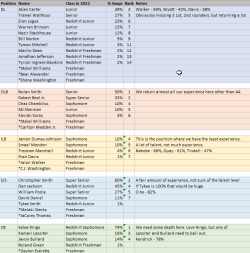The Athletics' Andy Staples put these out for pods in all P5 conferences:
Paywall:
We took a try at creating some sensible division-free schedule formats for the Power 5 conferences, possibly to save them from themselves.

theathletic.com
Big 10
Illinois — Northwestern, Ohio State, Purdue
Indiana — Purdue, Maryland, Rutgers
Iowa — Wisconsin, Nebraska, Minnesota
Maryland — Rutgers, Nebraska, Indiana
Michigan — Ohio State, Michigan State, Minnesota
Michigan State — Michigan, Penn State, Northwestern
Minnesota — Wisconsin, Iowa, Michigan
Nebraska — Iowa, Maryland, Wisconsin
Northwestern — Illinois, Purdue, Michigan State
Ohio State — Michigan, Penn State, Illinois
Penn State — Michigan State, Ohio State, Rutgers
Purdue — Indiana, Illinois, Northwestern
Rutgers — Maryland, Penn State, Indiana
Wisconsin — Minnesota, Iowa, Nebraska
Even though we didn’t compare notes beforehand, Dochterman and I didn’t differ much.
Here are the SEC groupings I proposed in August when the buzz about the nine-game conference schedule began percolating. This would end the madness of teams that aren’t in the same division and aren’t fixed opponents playing only twice every 10 years.
Alabama — Auburn, Mississippi State, Tennessee
Arkansas — Kentucky, Missouri, Texas
Auburn — Alabama, Georgia, Vanderbilt
Florida — Georgia, Tennessee, LSU
Georgia — Auburn, Florida, South Carolina
Kentucky — Arkansas, Mississippi State, South Carolina
LSU — Florida, Ole Miss, Texas A&M
Mississippi State — Alabama, Kentucky, Ole Miss
Missouri — Arkansas, Oklahoma, Texas A&M
Oklahoma — Missouri, Ole Miss, Texas
Ole Miss — LSU, Mississippi State, Oklahoma
South Carolina — Georgia, Kentucky, Vanderbilt
Tennessee — Alabama, Florida, Vanderbilt
Texas — Arkansas, Oklahoma, Texas A&M
Texas A&M — LSU, Missouri, Texas
Vanderbilt — Auburn, South Carolina, Tennessee
In the Big Ten, I defaulted to creating annual matchups TV networks would covet. I did not use that as a decision-maker for every SEC decision because certain teams would have become overloaded. Florida and LSU would love to play Auburn annually, but replacing Vanderbilt with either of those wouldn’t be fair to Auburn, which already has to play Alabama and Georgia. Tennessee also could be claimed by Georgia as a rival, but the Volunteers already have Alabama and Florida every year. Plus, someone has to play Vanderbilt.
The ACC already showed us what a division-free season can look like in a super-sized conference. The 2020 season ended with two of the ACC’s teams in the four-team playoff, which is why it’s a mystery as to why the ACC even went back to divisions at all. The 2021 season brought us a non-conference game between conference members Wake Forest and North Carolina, which are 81 miles apart and had grown tired of not playing one another. Such silliness would be unnecessary with a format just like the one proposed above for the Big Ten, which also has 14 teams.
Boston College — Miami, Syracuse, Virginia Tech
Clemson — NC State, Georgia Tech, Florida State
Duke — North Carolina, Wake Forest, Syracuse
Florida State — Miami, Clemson, Georgia Tech
Georgia Tech — Clemson, Florida State, Louisville
Louisville — Pittsburgh, Virginia Tech, Georgia Tech
Miami — Florida State, Boston College, Pittsburgh
North Carolina — Duke, NC State, Virginia
NC State — Clemson, Wake Forest, North Carolina
Pittsburgh — Louisville, Miami, Syracuse
Syracuse — Boston College, Duke, Pittsburgh
Virginia — Virginia Tech, North Carolina, Wake Forest
Virginia Tech — Virginia, Louisville, Boston College
Wake Forest — Duke, NC State, Virginia
I ran this list past one colleague who asked why I didn’t just have a round-robin between all the North Carolina schools. Virginia and North Carolina have played 127 times, and rivalries that ancient must be honored. As for the others, I tried to make sure all blood feuds are played. Florida State and Miami obviously must meet annually. I kept the Textile Bowl between Clemson and NC State. I tried to rekindle some old Big East rivalries. But because so much of the league was Frankensteined together to keep it from being picked apart by stronger conferences, most of the matchups didn’t feel particularly sacred.
It got a little trickier with the Big 12 and Pac-12, which we assume will each have 12 members when the dust settles. The Pac-12’s two-division format with a nine-game conference schedule actually works quite well in terms of exposure to all the teams in the league, but the league plans to cut down to eight games. Also, the problem of the potential fluky conference champ still remains. So let’s move that league to an eight-game schedule where every team plays two fixed opponents annually and the other nine schools rotate through the six remaining schedule slots. Then end with a No. 1 versus No. 2 title game in Vegas.
Arizona — Arizona State, Colorado
Arizona State — Arizona, Utah
Cal — Stanford, UCLA
Colorado — Utah, Arizona
Oregon — Oregon State, Washington
Oregon State — Oregon, Washington State
Stanford — Cal, USC
UCLA — USC, Cal
USC — UCLA, Stanford
Utah — Colorado, Arizona State
Washington — Washington State, Oregon
Washington State — Washington, Oregon State
The old Pac-10’s system of travel partners made choosing one fixed opponent very easy, and the desire of the Bay Area schools and the Los Angeles schools to play annually made distributing the second teams fairly easy. Oregon-Washington was the only interstate rivalry that really needed to be honored. The rest of the Pac-12 is a lot more chill about this stuff than the Big Ten or the SEC — which is kind of the Pac-12’s problem.
We’re assuming the Big 12 stays at nine conference games, though it certainly could drop to eight if the members chose. For now, we’ll go with three fixed opponents annually and the other eight schools rotating through the remaining six schedule slots.
Baylor — TCU, BYU, Houston
BYU — UCF, Cincinnati, Baylor
Cincinnati — BYU, West Virginia, TCU
Houston — Texas Tech, Baylor, West Virginia
Iowa State — Kansas State, Kansas, TCU
Kansas — Kansas State, Iowa State, Texas Tech
Kansas State — Iowa State, Kansas, Oklahoma State
Oklahoma State — UCF, Texas Tech, Kansas State
TCU — Baylor, Iowa State, Cincinnati
Texas Tech — Oklahoma State, Houston, Kansas
UCF — BYU, West Virginia, Oklahoma State
West Virginia — Cincinnati, UCF, Houston
The construction of the league made the choices less difficult. Former Big Eight members Iowa State, Kansas and Kansas State should play annually. We couldn’t cancel a game called Farmageddon, so Iowa State vs. Kansas State isn’t going anywhere. Oklahoma State also was in that league, but the Cowboys probably would prefer getting into Texas and Florida for recruiting purposes. Houston gets to see former Southwest Conference foes Baylor and Texas Tech annually. BYU has a national following, so it gets the widest spread of annual opponents. We’ve also created an annual Mormons vs. Baptists game that undoubtedly will spawn a lot of T-shirts. West Virginia, meanwhile, gets to not feel so alone with Cincinnati and UCF on the schedule every year.
The Big 12 doesn’t have to take this advice, of course. It could continue and go back to divisions, which almost certainly won’t come back to bite it in the butt. Or it could act like the trailblazer it is and stay division-free forever.




